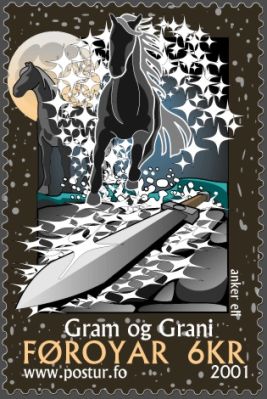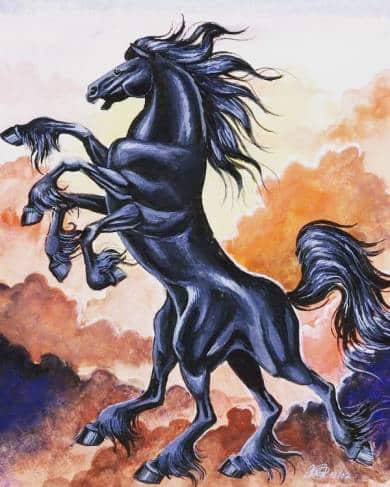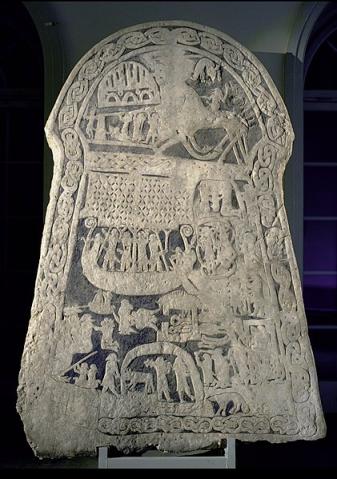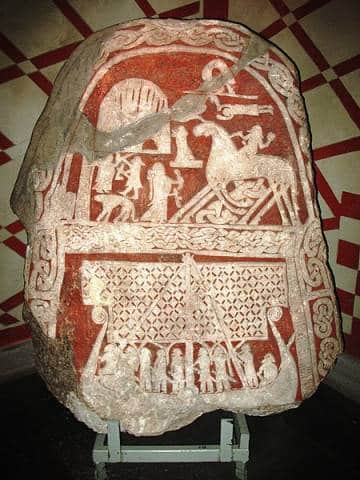Norse mythology has a rich collection of fascinating gods, animals and incredible creatures. From the mighty Thor and his hammer to the cunning Loki and the all-knowing Odin, the stories and characters of Norse mythology have left a lasting impression on the world. One such character that stands out is the powerful and majestic eight-legged horse of Odin, Sleipnir.
Who is Sleipnir?
Sleipnir is not just a simple horse, but a symbol of strength, speed, and cunning in Norse mythology. He is “Sleipnir the best of steeds”, according to Odin in stanza 44 of Grímnismál.

In Norse mythology, horses were considered symbols of power and strength. They were often associated with the god of war, Odin, and were considered sacred animals. Sleipnir, being the horse of Odin, represents the god’s own strength and power. He is also a symbol of speed and cunning, and said to be able to cross both land and water faster than any other.
Meaning and etymology of the name Sleipnir
The name Sleipnir (Old Norse Sleipnir) is derived from the Old Norse word “sleipr,” which means “slippy” or “smooth.” This seems to refer to the horse’s ability to travel not just faster than anyone, but also to any realm. Slipping through the realms like no other being is able to, even slipping out of the gates of Hel.
Description
Sleipnir is described as gray, with eight legs and the fastest and strongest horse ever to have lived. His size is interestingly enough, seemingly somewhat dynamic, like many of the gods are as well. As Odin sometimes travels on him in disguise through Midgard, Sleipnir is a powerful and large horse, but no more.
However, according to legend, Odin and Sleipnir once rode through Midgard and Sleipnir put his one hoof down so hard it left an imprint. This imprint is the Ásbyrgi canyon found on Iceland, measuring a cool 0.7 miles across and 2.2 miles in length. Based on standard hoof-to-height dimensions for horses, this might make Sleipnir 20 miles tall.
Sleipnir’s Origins and Family
To say that Sleipnir has an interesting parentage is to put it mildly. He is in fact the unlikely son of the magical jötun stallion Svidilfari and the god Loki.
How this came to be is told in the story “The fortification of Asgard” found in the Gylfaginning part of the Prose Edda.

Svadilfari the magical jotnar stallion
After the gods created the nine realms and Valhalla, an unknown visitor came to Asgard. He offered to build them a fortification around Asgard, impenetrable to anyone. He would do so in less than three seasons, if he could get Freyja as a bride, the moon and the sun as payment. After some consideration, the gods agreed to the unknown builder’s demands of payment for the job. The price might seem steep, but the Aesir had no plans to ever pay.
Loki had assured everyone that the builder would not be able to finish in time so no payment was needed. However, the jötun had a horse called Svadilfari and he turned out to be magical. He would pull large stones from far away and build on the wall tirelessly day and night.
When the walls were nearly finished and there was a day or two left, the Aesir grew worried. The cunning Loki however promised he would find a solution. That night, when the jötun went to sleep leaving Svadilfari to his work, Loki changed into a mare.
Never had Svadilfari seen such a beautiful mare and he galloped after her, running all night to catch up. Loki managed to keep him occupied, the time ran out and the jötun builder was thrown out with no payment.
Some time after this, Loki, as a mare, gave birth to an eight legged gray foal. Seeing it was a special horse, quick and growing fast he gifted Sleipnir to Odin.
Sleipnir’s half-siblings
As the events leading up to Sleipnir’s birth was early in the history of the Aesir, he is likely the first of Loki’s children. As such, he is the big half-brother to Loki’s other infamous children Hel, Fenrir and Jormungand.
Scholars have argued that the story of Loki being the mother to Sleipnir might have been invented by Snorri Sturluson, but that has not been firmly established. Loki is often instrumental in creating many of the gods’ most cherished possessions so to me it makes perfect sense.
Sleipnir’s son Grani
Clearly seen differently than his half-siblings, legend has it that Sleipnir also fathered the hero Sigurd’s horse Grani. This is detailed in the sags of the Völsungs chapter 13, excerpt below, translation adapted by me
“So the next day Sigurd went to the forest, and on the way there he met an old man, long-bearded, that he didn’t knew, who asked him where he was going.
Sigurd said, “I plan to find me a horse; would you come, and give me counsel?”
“Well then,” said the old man, “we should go and drive them to the river which is called Busil-tarn.”They did so, and drove the horses down into the deeps of the river, and all swam back to land but one horse; and that horse Sigurd chose for himself; grey he was of color, and young of years, great of growth, and fair to look on, nor had any man yet crossed his back.
Then spoke the grey-beard, “From Sleipnir’s kin is this horse come, and he must be fed well, for it will be the best of all horses;” and after that he disappeared.
So Sigurd called the horse “Grani, the best of all the horses of the world; and the man he met was no other than Odin himself”.
According to legend Sigurd also had a magical sword called Gram, both are depicted in this Faroe islands stamp.
Play Fun Norse Quiz
Is this article making you even more curious about Norse gods and goddesses? You can satisfy your curiosity by playing a fun Norse mythology quiz. This way, you can test your knowledge about Norse gods and goddesses, as well as fill in some gaps. Good luck and have fun playing!
Don’t forget to try our other games as well!
Sleipnir riding through the Eddas’ and Sagas
As Odin’s horse, Sleipnir is often accompanying him on adventures and is mentioned several times in the Eddas and Sagas. Not always taking an active part, Sleipnir is also sometimes just referred to by Odin or others.

Thor’s Duel with Hrungnir
The story about Thor’s duel with the jötun Hrungnir, the strongest of all the jotnar, starts with Odin and Sleipnir. One day they are out riding in Jotunheim and they meet a jötun and his horse Gullfaxi (meaning Goldenmane).
They soon start discussing their horses and Hrungnir, calling Sleipnir a pretty little horse, challenges Odin to a race. The threat of consequences of immediate death for whoever loses flies through the air as Hrungnir rides straight at Odin.
The race tests both horses’ ability and Sleipnir and Gullfaxi are proving themselves almost equally matched. However, the tables are turned as they fly through the gates of Asgard and Hrungnir is suddenly trapped.
The story ends in a duel between Thor and Hrungnir, where the former smashes the head of the latter.
Baldr’s Dreams

In Baldr’s dreams the god Baldr is worried from troubling dreams about impending doom. After having counsel with all the gods and goddesses, Odin saddles Sleipnir and rides to Hel.
Here from the second stanza of Baldr’s Dreams in the Poetic Edda:
“Then Odin rose, | the enchanter old,
And the saddle he laid | on Sleipnir’s back;
Then rode he down | to Niflhel deep,
And the hound he met | that came from hell.”
Meeting the hell-hound Garmr, Odin and Sleipnir ride on to find a dead völva Odin knows of. He then proceeds to raise her from the dead using magic spells and his powers. Odin learns that Baldr is doomed to die at the hand of his blind brother Höd.
Hermod’s Ride to Hel
After the sad events prophesied by the Völva in Baldr’s Dreams play out, Baldr is trapped in Hel. Desperate for the return of her son, Odin’s wife Frigg asks if anyone can go and try to get her son back. Hermod borrows Sleipnir and goes, and this is how it is described in chapter 15 of the Gylfaginning.
“But of Hermod it is to be told that he rode nine nights through deep and dark valleys, and did not see light until he came to the Gjallar-river and rode on the Gjallar-bridge, which is thatched with shining gold. Modgud is the name of the jötun maiden who guards the bridge. She asked him for his name, and of what kin he was, saying that the day before there rode five armies of dead men over the bridge; but she added, it does not shake less under you alone, and you do not have the hue of dead men.
Why do you ride the way to Hel? He answered: I am to ride to Hel to find Balder. Have you seen him pass this way? She answered that Balder had ridden over the Gjallar-bridge; adding: But downward and northward lies the way to Hel. Then Hermod rode on till he came to Hel’s gate. He alighted from Sleipnir, drew the girths tighter, remounted him, clapped the spurs into him, and Sleipnir leaped over the gate with so much force that he never touched it.”
Sleipnir Mentions
As noted before, Sleipnir not only plays a part in many stories, he is also referenced several times. A few interesting ones follow here, but I am sure I have missed some as well.
The Riddles of King Heidrek
In the Saga of Hervor and Heidrek a dishonest man called Gestumblindi is summoned to king Heidrek. There he is to answer for his crimes. Trying to find a way out of his possibly fatal meeting, Gestumblindi prays to Odin for help and receives it.
In a series of riddles Odin, in the guise of Gestumblindi, and king Heidrek have a battle of wits. Much like in Vafthruthnirsmal and other instances where riddles are involved, the stakes are high and the riddles hard.
Odin/Gestumblindi:
“Who are those two, who have ten feet, three eyes, and one tail? King Heidrek, think about the riddle.”
Heidrek:
“You are really making a game of it now, when you find in your deliveries to me those wonders which happened in ancient times; that is when Odin rode the horse Sleipnir; he had eight feet, and Odin two, and they had three eyes, Sleipnir two and Odin one”.
Völuspá
In stanza 53 of the Völuspá, the Seeress Prophecy, we learn what is to become of Odin. As it is inconceivable that Odin would walk into battle it is understood that he faces Fenrir sitting on Sleipnir.
“Then arises Hlîn’s second grief,
when Odin goes with the wolf to fight,
and the bright slayer of Beli with Surt.
Then will Frigg’s beloved fall”.
As is so often the case in Norse mythology, warriors often meet close relatives in battle. Together, Odin and loyal Sleipnir face the Fenrir wolf, his half-brother, and they are ultimately killed.
Featured Image Credit: W.G. Collingwood (1854 – 1932), Public domain, via Wikimedia Commons
